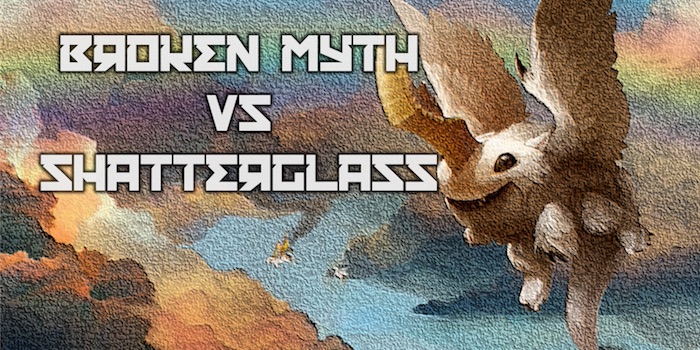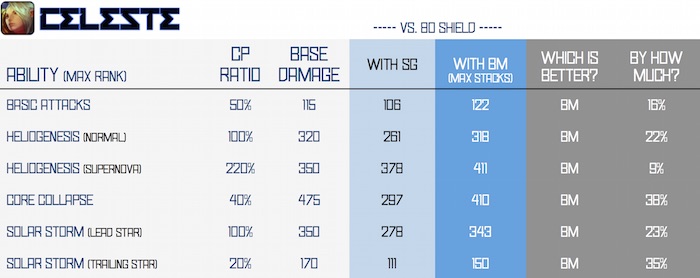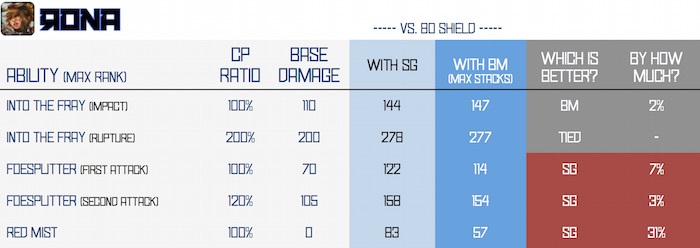A frequent question I hear in the Vainglory community is “Shatterglass or Broken Myth?” The answer to this question, however, isn’t completely black and white, depending upon several variables, including what hero you’re playing and what your intended item build looks like. We’re going to cover these variables both generally as well as specifically during the remainder of this guide.
Overview
There are four key metrics that help determine if Broken Myth (BM) will outperform Shatterglass (SG):
- Base damage of the ability being used
- Crystal power (CP) ratio of the ability being used
- Shield defense of the target
- Length of combat engagements
Since BM enhances all crystal damage, the greater the base damage of an ability, the greater the probability that BM will outperform SG. Conversely, the larger the CP ratio, the more likely the raw crystal power of SG will outperform BM.
If the target has purchased shield defenses, the 10% shield pierce on BM plays a more significant role, helping it to outperform SG.
Lastly, if combat engagements are short and there is not enough time to build stacks on BM, the upfront damage of SG may prove to be superior.
Methodology
The following charts will provide you a hero-by-hero and ability-by-ability analysis of how BM performs in comparison to SG. The following assumptions are being used (unless otherwise stated):
- Your hero is level 12
- Each ability is measured at max rank (rank 5 for A and B; rank 3 for C)
- There are no other items in your inventory (i.e. SG or BM will be your first purchase)
- The target has 80 shield defense, which is the average shield defense of a level 12 hero with no defensive items
- Broken Myth is able to reach six stacks of bonus crystal damage, for a total of 36%
Generally, you’re going to find that a fully stacked BM will outperform an SG; when it doesn’t, I will color the appropriate fields red. The trade off is that you need to actually build those BM stacks in order to see the superior benefit. A BM with no stacks is the equivalent of a Piercing Shard and a Heavy Prism, which isn’t very spectacular when compared to an SG. Additionally, since there is a “ramp up time” for BM (i.e. while you build stacks), I would say that any situation where a fully stacked BM is better by less than a 10% margin is probably a situation where you couldn’t go wrong with either an SG or a BM – it’s fairly even.
As a final note before proceeding, make sure to to read the text under each chart before forming conclusions. There are scenarios where BM may look better on paper, but SG may be a better fit. Also, since % health damage is a variable, any abilities or items that include such damage will be found in the text, but not in the chart.
Synergy with other CP Items
Before diving into the heroes, let’s briefly talk about item build synergies that exist between BM and items such as Aftershock and Alternating Current, both of which benefit from the the bonus crystal damage of BM.
Aftershock’s passive scales off of your target’s health, does not have a CP ratio, and counts as crystal damage, so it benefits from shield piercing; therefore, BM is a clear winner, bringing the 15% health damage up to a little over 20% (with full BM stacks) and providing 10% shield pierce to reduce the amount of damage mitigation from shield defenses.
For Alternating Current – see chart above – the base damage is fairly low and the CP ratio is moderately high, both of which are unfavorable conditions for BM, thus defaulting to SG as the top synergy.
Keep these synergies in mind as we consider not only what hero abilities work best with SG/BM, but also what item builds will synergize the best.
Synergy with Hero Abilties
With base ability damages that are relatively high in comparison to their CP ratios, BM has decent conditions for fitting into an Adagio build, but there are some caveats. It’s worth noting that if you did not overdrive Agent of Wrath (i.e. you only went to rank 4), the base damage drops to 65 (almost cut in half), causing SG to be the better selection. Also, if you’re considering which CP item would provide the most amount of increased healing to your team (via Gift of Fire), SG would win hands down because BM only increases crystal damage (not healing).
It’s rare to see an Ardan who isn’t itemizing for the support role and even rarer to see a CP build. Nevertheless, here are the numbers to satisfy your curiosity.
Since Feint of Heart it counts as a basic attack and does not have any base crystal damage, SG wins without any competition. Additionally, the benefits of BM to his heroic perk, Heartthrob, and On Point have such a small edge over SG that I’d inclined to rule in favor of SG as the overall better selection for Blackfeather, the latter not requiring any ramp up time. However, if you expect your opponents to build shield defenses against you, BM would win out.
Another situation where the hero in question is predominantly played in the support role. However, I have seen a few occasions where Catherine players experiment with crystal builds, so maybe this will be useful to someone.
When BM is somewhat consistently outperforming SG by a margin of 20% or more across all abilities, it becomes an easy decision. In general, BM is a solid choice for Celeste. It is worth noting that the Heliogenesis super nova gets a very tiny boost to to base damage, but a large boost to the CP ratio, this diminishing the comparative damage boost of BM; however, in addition to BM, a lot of Celeste players will pick up a CP heavy item, such as Frostburn or SG, to leverage the larger CP ratio and balance the build.
BM tends to outperform SG by a sizable margin when paired with Fortress’ kit. One measurement that is not displayed here is the % health damage when Law of the Claw reaches max stacks. At rank 5 it is 20% with a 6% CP ratio. A fully stacked BM brings this to 31.4% while an SG brings it to 29%. This around an 8% performance gain, not including the 10% pierce from BM.
On paper, BM seems to be the superior choice for Glaive, with the exception of Twisted Stroke, which lacks any form of base damage. However, depending on how you intend to build or play a CP Glaive, BM might not be a great fit. More particularly, if you’re leveraging more of a bursty, hit-and-run play style, this won’t be conducive to building BM stacks.
If, like many CP Joule players, you’re trying to delete your opponents with a well-placed Big Red Button (BRB), BM can be a solid purchase. Admittedly, SG will outperform BM if you’re using your BRB or Rocket Leap to initiate team fights or surprise your opponents – there’s no time to build BM stacks in those scenarios.
As a side note, I measured Thunderstrike with and without its additional 10% armor/shield pierce. In both scenarios, a fully stacked BM outperformed SG by 7%.
While a fully stacked BM sees some marginal performance gains over SG on her Glimmershot and Active Camo, I’m inclined to rule in favor of SG as the better choice for Kestrel. The play style of CP Kestrel often involves sudden bursts of damage and not extended back-and-forth exchanges. You want to be able to pop out of stealth and instantly unload your damage, which is not conducive to building BM stacks. Also, her ultimate’s base damage is all weapon-based, so the only way to significantly boost it further is by leveraging the 260% CP ratio, which makes SG the superior choice (as shown above). Lastly, the stealth and mist duration of Active Camo is increased by raw crystal power, making SG (again) the better fit.
On Koshka, a fully stacked BM significantly outperforms an SG. As an added benefit, most Koshka players build Aftershock, which – as previously mentioned – also takes advantage of the bonus crystal damage and shield piercing that BM provides, creating a powerful synergy with both the hero abilities and the item build.
With low CP ratios and high base damages, BM is a dream come true for Krul. Admittedly, finding a CP – or even a hybrid – Krul is almost unheard of. I’d really like to see someone figure out a way to successfully fit BM into a Krul build someday. I’m looking at you, AdyEndrus.
With relatively low CP ratios, BM tends to suit Petal nicely. Also, the nibbling of those munions can be a great way to build BM stacks. Lastly, Spontaneous Combustion is often an ability that is used mid-fight, particularly due to its burst of healing for the team; you can usually count on having a decent amount of BM stacks when you decide to pull the trigger.
Overall, BM is a solid choice for Phinn. Phinn is accustomed to sitting in the middle of team fight and soaking up damage, so building BM stacks isn’t too much of a concern for him. Also, his primary source of damage, Quibble, will hit like a truck with full BM stacks.
If you can’t tell by the amount of red in this chart, SG is generally going to be a better selection for Ringo – and for good reason. First, Twirling Silver has no base damage for BM to enhance, leaving you with a CP ratio to work with and making SG the superior choice. Second, while Hellfire Brew has fairly low CP ratios (normally a bad sign for SG), the ability also comes with 100% shield pierce, thus negating the shield pierce benefit of BM. Not to mention that the Hellfire Brew of a CP Ringo is often a great initiation tool, meaning there are times where you won’t have opportunity to build BM stacks before using it.
With fairly low base damages and decent CP ratios, SG is a superior choice for building CP Rona. In particular, her Red Mist’s base damage is all weapon-based, so the only way to enhance the damage further is via heavy crystal power, which is what SG is good for.
Based on this chart alone, I’d say CP SAW is better off building an SG. However, something that is not accounted for in this chart is the execute damage on both Roadie Run (45% of missing health) and Mad Cannon (15% of missing health). Since this execute damage scales with missing health and not with any sort of crystal ratio, the 36% crystal damage enhancement and 10% shield pierce from BM are huge benefits to a CP SAW, particularly when trying to assassinate your opponent with Roadie Run.
Generally, the mages of Vainglory (i.e. Skaarf and Celeste), tend to benefit more from BM more than SG, often because they’re designed to rely upon their abilities for damage and thus their abilities have a good base damage to begin with. One item not accounted for in this chart is Skaarf’s heroic perk, Fan the Flames (FtF), which does its damage based on % of missing health, but also scales with crystal power. After running some numbers, BM has slightly higher FtF performance due to its shield piercing, but is otherwise fairly close in performance to SG.
Skye tends to like BM over SG. In particular, the low CP ratio on Death from Above causes BM to really shine. It is worth noting that it is very popular for CP Skye players to finish a Frostburn before anything else, thus changing the chart to look more like this:
The key principle is that any crystal power you purchase before BM will effectively increase the base damage. For example, the 100 CP from Frostburn is effectively increasing the base damage of Forward Barrage from 360 to 570; and, as we know from the beginning of the article, the larger the base damage, the greater the benefit from BM.
During the second half of 2015, the base damages of Taka’s X-Retsu and Kaiten were reduced, but BM continues to be the superior choice. Admittedly, CP Taka is often about burst damage and hit-and-run tactics, which are not usually conducive to building and using BM stacks, so be introspective about your play style.
Kind of like Joule’s Big Red Button, Vox’s ultimate, Wait For It, is a devastating AOE nuke. Since the CP ratio was removed earlier this year, BM is by far the superior choice for enhancing its damage output. On the complete opposite end of the spectrum, the resonance damage from Pulse has a flat CP ratio without any base damage, so BM’s benefit would be minimized until some additional crystal power was procured.
The SG vs. BM debate doesn’t end at Vox’s abilities though. There are some CP Vox builds that leverage Aftershock (synergizes with BM and not SG) and some builds that leverage Alternating Current (synergizes better with SG). Keep both Vox’s build and abilities in mind when making the SG vs. BM decision.
I hope this helps everyone understand their item builds a little better. If there are other questions you’d like to see answered in the future, post them in the comments.
























7 Comments
Kite
Jan 08, 2016 4:25 amIt is also worth clearly mentioning if and how you took into consideration the CP ratio on the duration of Skye’s Forward Barrage.
Gadianton
Jan 08, 2016 4:43 amThat was certainly taken into account. but only mentioned indirectly in the article. You’ll see in the chart that I mentioned “per second” for the damage of the ability. Since most Skye players start with Frostburn, this caps out the Forward Barrage duration at 3 seconds anyway.
Kite
Jan 08, 2016 2:21 amVox’s resonance also has base damage. I do not know precisely how it works, but Vox with no CP items can definitely deal resonance damage. Vox’s resonance damage against non-heroes, against minions, is exactly the same as the crystal portion of his basic attack.
Gadianton
Jan 08, 2016 4:40 amThe ability Pulse does not do *any* damage when it hits the target – it only slows – therefore it doesn’t have any base damage.
As far as, the damage of resonance bounces, I listed it as a CP ratio, but it’s actually labeled as a “damage bonus”, meaning that when you have rank 5 Pulse, your resonance bounces will do 125% of your attack damage to nearby enemies. Therefore, without any items, it will still take your base attack damage (plus heroic perk) and then bounce that damage to nearby targets.
SlikRiick
Jan 03, 2016 9:57 amGreat article! I main as Koshka and I’ve struggled with BM because usually early game I’m bursting people down before I could build stacks and late game I get focused and die before reaching its potential. Your article gives me some clarity:
– I always build Aftershock first (I tend to regret it when I don’t)
– If I’m snowballing/they don’t build shield its fine to follow that up with SG and AC
– Otherwise frostburn + BM
With frostburn and BM I need to pounce in, twirl, get out, then pounce back in before I start losing stacks. And finger off that C until we’re chasing someone down or a 3v2 or better
Just thinking out loud here, thanks!
Kite
Jan 01, 2016 7:22 pmI noticed an error in a calculation. The CP ratio for Adagio’s Agent of Wrath is dated, and should be 85% rather than 65%.
Gadianton
Jan 02, 2016 7:53 amThank you for catching this! I have updated the chart and text to reflect this.